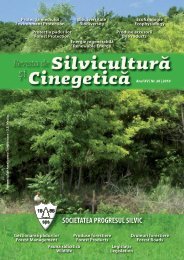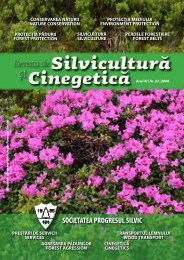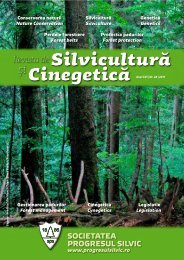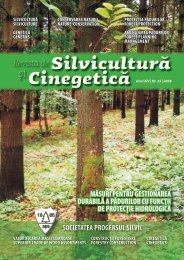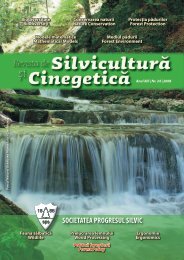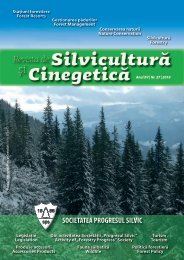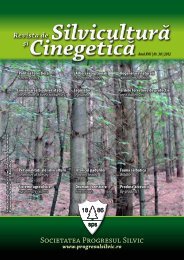Silviculture and Cinegetics Review - Societatea Progresul Silvic
Silviculture and Cinegetics Review - Societatea Progresul Silvic
Silviculture and Cinegetics Review - Societatea Progresul Silvic
You also want an ePaper? Increase the reach of your titles
YUMPU automatically turns print PDFs into web optimized ePapers that Google loves.
FORESTRY BELTS SILVICULTURE AND CINEGETICS REVIEW XVII/30/2012<br />
Making watercourses protection forest belts should be<br />
a priority in our country due to systematic removal of<br />
existing forest vegetation along watercourses, around<br />
lakes or ponds <strong>and</strong> l<strong>and</strong> use for agricultural l<strong>and</strong><br />
expansion or for community development. Along the<br />
main rivers, the area occupied by forest, on a corridor<br />
of 1.5 km on either side, range from 10.21% for the<br />
Siret River to 26.77% for Jiu River (Mihăilă et al.<br />
2010). Lack of vegetation adjacent to such waters<br />
increased risk of flooding <strong>and</strong> favored discharge of<br />
many residues in the water, erosion of banks,<br />
degradation of aquatic habitats <strong>and</strong> acceleration of<br />
sediment deposition in streams, lakes <strong>and</strong> ponds.<br />
Watercourses protection forest belts perform multiple<br />
functions, mainly of protection: (i) drought <strong>and</strong><br />
erosion protection; (ii) reduction in wind erosion; (iii)<br />
fixing of banks; (iv) reduction in evaporation of water<br />
from rivers; (v) ensuring as steady flow rates as<br />
possible; (vi) curb the strong air currents (extremely<br />
harmful), such as those that cause dust storms; (vii)<br />
moistening slopes, by accumulating large amounts of<br />
water <strong>and</strong> snow precipitation, by promoting<br />
infiltration <strong>and</strong> supplying underground leakage; (viii)<br />
reduce flood damage; (ix) protecting dams during<br />
large floods.<br />
The importance assigned to them, their spread on<br />
large tracts <strong>and</strong> the high expenditure they require,<br />
make that these forest belts can only be achieved in<br />
projects at national level <strong>and</strong> with funding provided<br />
by the state. Setting priorities in designing such<br />
protection forest belts is required as a first step to<br />
achieve these types of forest belts. Before determining<br />
what kind of forest belt shall be installed in an area it<br />
should be considered each watercourse, in terms of<br />
climate <strong>and</strong> stationary conditions, of presence or<br />
absence of forest vegetation <strong>and</strong> of the main features<br />
that must be met by these forest belts (stabilization of<br />
banks, filter pollutants from agriculture or industry,<br />
etc.). Because it is impossible to install protection<br />
forest belts along the length of a river's water network<br />
there must be chosen those places, which assure their<br />
maximum effectiveness.<br />
.<br />
Choosing the best forest belts installation solutions<br />
involves choosing species, in accordance with<br />
stationary conditions <strong>and</strong> location, taking into account<br />
the main disruptive factors.<br />
Making watercourse protection forest belts requires<br />
the existence on both sides of the watercourse, of<br />
three areas differently made <strong>and</strong> with different<br />
functions, presented below (Anonymous 1997) (Fig.<br />
6).<br />
- Zone I is located immediately beside the water <strong>and</strong><br />
corresponds to water banks. Recommended species<br />
for this area are fast growing trees <strong>and</strong> shrubs, which<br />
support long-term flooding.<br />
This b<strong>and</strong> of trees: i) consolidates the banks, ii)<br />
provides a moderating water temperature, iii)<br />
enhances aquatic activity, through contribution of<br />
organic matter, provided by forest vegetation, iv) is<br />
the last filter for pollutants that come from agriculture;<br />
v) reduces fluctuations in water flow.<br />
- Zone II, wider than the first, is located in the vicinity<br />
of zone I <strong>and</strong> is composed of fast growing species of<br />
trees <strong>and</strong> shrubs, tolerant of short-term stagnation of<br />
water.<br />
Forest vegetation performs the following functions: i)<br />
retains nutrients <strong>and</strong> absorbs them, ii) provides rain<br />
water infiltration, iii) enhances biodiversity; iv)<br />
provides multipurpose wood <strong>and</strong> non-wood products.<br />
It is important that in choice of species be considered<br />
the root system <strong>and</strong> crown shape. Roots of species are<br />
designed to transform pollutants that come adjacent<br />
from l<strong>and</strong> preventing them from reaching into the<br />
water.<br />
Shade which trees provide leads to lower water<br />
temperatures, conditions which reduce algae growth<br />
<strong>and</strong> improves the oxygen content of water.<br />
Installation of a forest belt, with impenetrable<br />
structure (trees <strong>and</strong> shrubs) is to slow the water flow<br />
on the surface <strong>and</strong> promote its infiltration.<br />
Forest belt density will be established according to its<br />
primary role <strong>and</strong> the size of the watercourse.<br />
68



